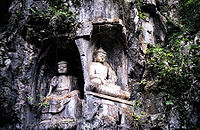- East Asian Mādhyamaka
-
Part of a series on Chinese Buddhism
History Major Figures Kumārajīva • Xuanzang
Huiyuan • Zhiyi • Bodhidharma
Huineng • Hsu Yun
Hsuan Hua • Nan HuaijinTraditions Chán • Tiantai • Huayan
Pure Land • Weishi • Sanlun • MizongTexts Chinese Buddhist canon
Taishō TripiṭakaArchitecture Buddhist Architecture in China
Sacred Mountains Culture Mādhyamaka in East Asia refers to the Buddhist traditions in East Asia which represent the Indian Mādhyamaka system of thought. In Chinese Buddhism, these are often referred to as the Sānlùn school (Ch. 三論宗), or "Three Treatise" school, known as Sanron in Japanese Buddhism.
Contents
History in China
The name Sanlun derives from the fact that its doctrinal basis is formed by three principal Mādhyamaka texts composed by Nāgārjuna and Āryadeva, which were then translated into Chinese by Kumārajīva. These three foundational texts are:[1]
- Nāgārjuna's Mūlamadhyamakakārikā, or "Fundamental Verses on the Middle Way" (Ch. 中論, T. 1564)
- Nāgārjuna's Dvādaśanikāyaśāstra, or "Treatise on the Twelve Gates" (Ch. 十二門論, T. 1568)
- Āryadeva's Śatakaśāstra, or "Hundred-Verse Treatise" (百論, T. 1569)
Nāgārjuna is traditionally regarded as the Indian founder of the Sanlun school, while Kumārajīva is traditionally regarded as the founder of Sanlun school in China.[2] However, the Three Treatise teachings were perhaps first propagated widely by Jizang.
In the 20th century, a famous monk of the Sanlun school was Venerable Yin Shun.
History in Japan
In 625, the Korean monk Ekan brought the Sanlun school to Japan, where it was known as Sanron. Like all early Buddhist schools in Nara, Japan it eventually died out and was absorbed by later Japanese Buddhist sects, such as Shingon and Tendai.
The Three Treatise School, in keeping with Madhyamika doctrine, teaches that all phenomena, including ideas and thoughts, are fundamentally empty of a permanent, static existence. This is also defined as shunyata in Buddhism. In conventional existence, all phenomena can be said to exist, have names and so on, but in the Sanlun school, the ultimate truth is their empty nature.
Notes
References
- Ven. Yin Shun (1998). The Way to Buddhahood: Instructions from a Modern Chinese Master. Wisdom Publications. ISBN 0861711335.
- Robert Magliola, "Nagarjuna and Chi-tsang on the Value of 'This World': A Reply to Kuang-ming Wu's Critique of Indian and Chinese Madhyamika Buddhism." Journal of Chinese Philosophy (U. of Hawaii; Blackwell P., U.K.). Vol. 31, No. 4 (Dec. 2004). Pp. 505-516. (Demonstrates Jizang neither denigrates 'this world' nor deviates from what was mainstream Indian Madhyamikan doctrine.)
Categories:
Wikimedia Foundation. 2010.

